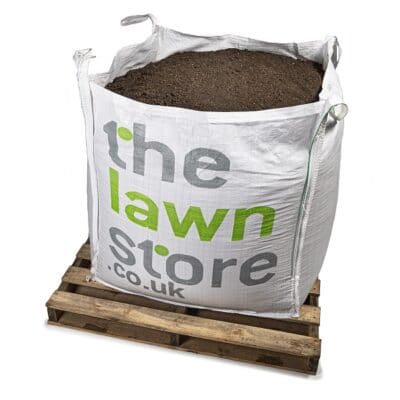How to Top Dress your lawn?
Top Dressing a lawn with a fine mixture of sand and loam is usually carried out following scarifying and aeration. The process helps to infill and smooth out imperfections in the surface of the lawn whilst assisting over-seed germination so that the lawn is revitalised. The best time of the year to carry out this process is late summer and autumn, but it can also be done in the spring providing you are able to water if conditions suddenly become dry.

Types of top dressing
There are various types of top dressing available, depending on your lawn environment. Most domestic lawns would benefit from a dressing with high organic content, to add fertility, whereas a fine sports surface will often benefit from a higher sand content to assist surface drainage and ball play. In simple terms a 50/50 top dressing will be 50% washed sand and 50% loam or organic matter. The first figure is the sand content, and the second figure is the loam content, so for example a 20/80 organic lawn dressing will be 20% washed sand and 80% organic matter. See our full range of top dressings…

The lawn renovation process
For best results when top dressing you need to create an environment when the dressing can be spread and worked into the lawn surface without totally smothering the existing grass plants.
To do this any surplus thatch, moss and flat lying grass must be removed by scarification. This process can be labour intensive due to the amount of material that will arise from the sward. The lawn can then be aerated to create thousands of holes, and then over-seeded before top dressing completes the process.
Our step-by-step guide on lawn renovation and Top Dressing

Step 1- Scarification
Scarify or rake out surplus thatch, moss, and flat lying grass. This can be done in multiple passes and directions with a scarifying machine. A machine can be hired to do this process and you will be amazed at the vast quantity of unwanted material that arises. Ideally scarify right down to the base of the grass plant so that soil is exposed.
Don’t be frightened if the lawn looks bare afterwards, this is a good thing as you have created space for the seed and top dressing to infill where only dead material was choking the lawn prior to this process.

Step 2- Aeration
Aeration can be done with a garden fork if, you are keen gardener with lots of time and energy, or ideally an aerating machine. An aerator machine is preferable as it can be fitted with spikes or hollow tines and will do a much better job than a garden fork. The aeration process creates thousands of holes throughout the lawn to relive compaction and to allow water, nutrient, and the top dressing into the rootzone. It also creates soil contact with the seed which is vital for good germination. Most machines penetrate to a depth of 75-125mm.

Step 3- Over-seeding
Over-seeding will ensure the lawn is revitalised and looks great when recovered. The seed can be broadcast by hand or with a rotary applicator at approximately 25 grams per square meter. The most important factors for successful lawn seed germination is to ensure that you have the three key elements which are soil contact, moisture and adequate temperature, this is why autumn is the best time to carry out lawn renovation. Different types of seed are available here and you can calculate how much is required using our handy lawn products calculator.

Step 4- Fertiliser Application
To ensure the lawn has the nutrient it needs to recover, a low nitrogen fertiliser should be applied at 30-40 grams per metre using a rotary applicator. We recommend our Natural Lawn Fertiliser which has low scorch potential and will gently release nutrient over 6-8 weeks.
During the autumn we use a fertiliser that is low in nitrogen and higher in phosphorus and potassium because it will promote seed germination and root growth throughout the establishment period and into the winter.
A higher nitrogen spring fertiliser can be used from March onwards to help the lawn thrive into the following spring and summer.

Step 5- Top Dressing
An 800-litre dumpy bag of top dressing covers 100-130 square metres. You can measure your lawn and check how much you need on our lawn products calculator. The top dressing should be spread evenly all over the lawn, no deeper than 10mm. This can be done using a wheelbarrow and shovel or a professional mechanical top dresser. For levelling deeper dips and imperfections we recommend using our fine Premium Topsoil. Once the dressing is spread it should be bushed or worked into the surface using a broom, lute or drag mat. This will ensure any imperfections are ironed out and it will blend the dressing with the seed. It is a good idea to keep a bit of seed back to lightly sprinkle across the surface of the lawn once top dressing is completed.

Step 6- Aftercare
Once you have completed a lawn renovation the best thing to do is to stay off the lawn for as long as possible to give it a chance to recover. Once the grass gets to 50-75mm long the first mow should be carried out being carful not to mow too short to start with. Always collect the clippings and ensure the mower has a sharp blade. If conditions turn dry watering will help recovery, however autumn lawn renovations will usually not require watering as rain will eventually arrive. The lawn may appear patchy for the first few months following renovation as the new seed germinates and establishes, this is normal as the lawn will recover over time and will be rejuvenated for the following season. A lawn care programme of nutrient, weed control and moss control will help to keep the lawn healthy in the future.


